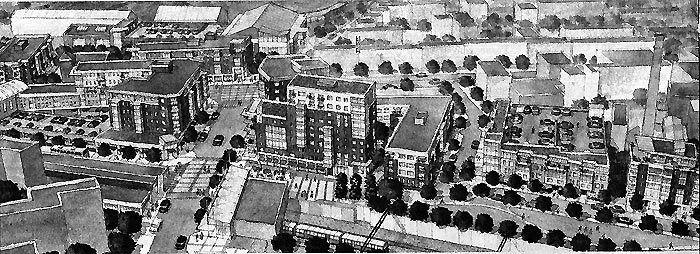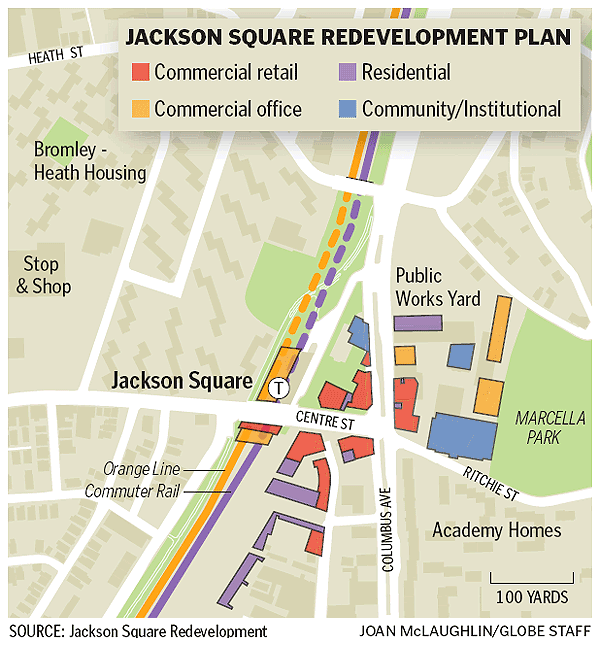A new look for Jackson Square
Developers shaping plan for residential, retail area
By Brian R. Ballou, Globe Staff | February 20, 2007
It is prime real estate in Boston and developers have long clamored to get their hands on it, but the 9.5 acres scattered near the intersection of Columbus Avenue and Centre Street in Roxbury and Jamaica Plain has remained a blank slate for almost 30 years.
Nearby is the Academy Homes housing development, which has battled crime. The Jackson Square T station, where some residents fear to tread after dark, is across the street. Then, there is the Bromley-Heath housing project , a red-brick behemoth that has struggled with gang activity. A 13-year-old boy was shot last month as he walked on Horan Way, a street within the development. The boy, who had left the Jackson Square T station moments earlier, ran back to the station but collapsed on a basketball court nearby.
City leaders, community activists, and business owners are working hard to change the image of Jackson Square. The city is fine-tuning a $250 million plan for 400 housing units, 60,000 square feet of retail space, and a youth and family center on the land. Groundbreaking is expected in the summer of 2008, said Tom Miller , the director of economic development for the Boston Redevelopment Authority.
"Jackson Square is a perfect example of an area that has seen better days," Miller said. "For some reason, the location never took off. But we think this is going to be incredible, and we're hoping it will lead to other construction projects in adjacent properties. We think this will serve as a catalyst for the area."
A busy strip mall containing a supermarket and a concentration of restaurants, music stores, and clothing boutiques dot the lower end of Centre Street, near Columbus Avenue. But closer to the intersection are the lots, land that was cleared about three decades ago to make way for a planned extension of Interstate 95. A Department of Public Works salt shed and a Department of Youth Services facility sit on a section of the property.
Two groups vied to develop the coveted land, but the city decided last November that both groups should work together on the project. The team now includes the Hyde Square Task Force, the Jamaica Plain Neighborhood Development Corp., Urban Edge, Mitchell Properties, and Gravestar Inc.
Jesus Gerena, director of Community Development and Organizing for the Hyde Square Task Force, said the development would serve as a bridge between Roxbury and Jamaica Plain, separated by Columbus Avenue. "This is an area that has been targeted because the city understands the need for more youth facilities and positive opportunities."
Many residents and business owners have welcomed the project in community meetings. "More apartments in the area mean more people to come to my store," said Luis Gonzales , owner of Cristal Fruit , at the corner of Centre and Wise streets.
Mayor Thomas M. Menino referred to the undeveloped land as a dead spot in the community, and said, "If you do it properly, with the plans I've seen, it will be great for the area." He said the area has been stigmatized by "one or two high-profile crimes."
The Jan. 12 shooting of 13-year-old Luis Gerena, no relation to the task force official, sent shock waves through the neighborhood and reminded many longtime residents and business owners of a near-fatal attack that occurred almost three years ago at the T station -- the stabbing of a 14-year-old girl.
Jesus Gerena said the dozens of teenagers enrolled in the task force's various antiviolence programs were stunned by the homicide. "They were definitely taken aback by that murder. Any time you have violence in the area, it heightens the fear among the kids, because they have to walk through Jackson Square every day . There's a general sense that the violence is all around them."
Juan Carlos, 17, of Dorchester, who passes through the T station on weekdays on his way to school and work, said he heard about the fatal shooting. "It's kind of crazy, thinking that something like that happened near here. I know a lot of my friends are scared to walk around here at night because of that."
Last fall, Boston police and the FBI conducted a drug sweep through Bromley-Heath, charging 23 men with dealing cocaine in or near the complex, including an 18-year-old who was shot by police during the sweep. About half of those arrested were alleged associates of the Heath Street Gang, whose war with the rival H-Bloc gang had led to at least 20 shootings from January 2005 to October 2006, the FBI said.
But the T station has experienced a decline in crime, according to statistics from the MBTA Police. Last year, there were 11 reported incidents of violence at the station, the lowest amount since 2000. The number of incidents peaked in 2003 , with 28 .
Police Lieutenant Michael Shea , commander of the district including the Jackson Square station, said it is constantly manned by at least two officers. "We have a lot of visibility at the station, guys who know the people who come through here by first name." He attributed the decline in crime to a renewed focus by the Massachusetts Bay Transportation Authority several years ago to conduct community-style policing rather than confine their efforts to the station alone. Shea said he often meets with administrators at Bromley-Heath, the Hyde Square Task Force, and other local groups.
Aralis Santana , 16, a student at Prospect Hill Academy in Cambridge , said recently that she goes through the station at least once a day. "Nothing has happened to me in three years, but I'm never by myself at night because anything can happen."



